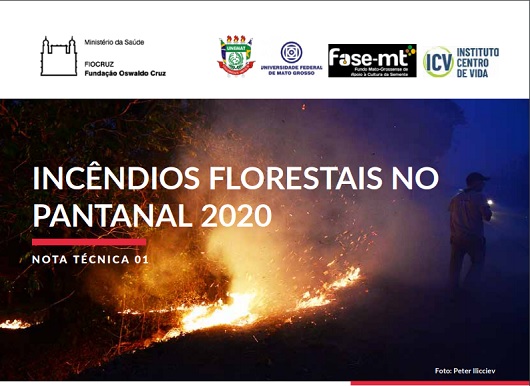Fiocruz assesses the impact of Pantanal fires on human health
22/10/2020
Julia Dias
The fires that have been hitting the Pantanal region for weeks is a threat not only to local fauna and flora but also to the human health of local populations, especially firefighters and nearby communities. In September, the number of fires in that biome hit a historical high. In addition to the immediate effects of fire and smoke, the loss of biodiversity and the drop of resources for the surviving species may cause animals to flee to unburnt areas, such as those occupied by humans, facilitating the emergence of new diseases. In the face of this prospect, Fiocruz has sent a team of researchers to the state of Mato Grosso, with the goal of carrying out a preliminary observation of the situation to get to know the dimension of the impact of these fires on human health and of visiting research groups with a tradition of studies in the region.

Fiocruz presented a team of researchers to Mato Grosso, with the aim of making a first observation of the situation and knowing the dimension of the impacts of the fires on health (photo: Peter Ilicciev)
The work proposal of the researchers is divided into three lines of action. The first aims to establish local partnerships to plan the evaluation of health issues in those directly involved in the fight against the fires, exposed to polluting agents, smoke, and extreme heat, with burns on the skin or in the lungs. The second line intends to monitor outbreaks of infectious diseases in animals, with the participation of the society, of government sectors and agencies, establishing surveillance for the possible emergence or reemergence of infectious agents and other diseases. The goal of the third line is to stimulate the planning, the integration and the implementation of a Pantanal Network of Information and Data of Biological Samples, in order to collect materials for diverse and multicentric studies, to train new professionals, and to preserve samples as testimonies for the future. The perspective of one health is used in the work, taking into account human, animal, and environmental health as indissociable.
“Very few phenomena can be compared with large forest fires when it comes to the ability to totally transform a natural ecosystem, in a short period of time, altering the use of soil in a catastrophic manner and consequently the store of natural resources”, explains the technical note drawn up by Fiocruz and partner institutions scientists. For Marcia Chame, the Fiocruz researcher who coordinated the field trip, “the dimension of these fires is really immense, in terms of fire extension as well as for its intensity and duration”.
Fiocruz published a first document on the situation.
The months of unprecedented fires may lead several species to extinction, putting at risk the unique biodiversity of the largest flooded area of the Americas. Natural areas of great biodiversity have, among other positive actions, the effect of diluting the transmission of pathogens. In addition to the environmental loss, this may signify the emergence of new, unknown diseases, or the reemergence of viruses that normally use animals as hosts, such as rabies or hantaviruses, for instance. It is estimated that 60% of infectious diseases involving humans have an animal origin.
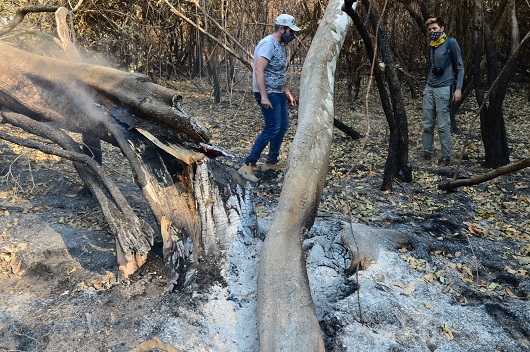
Natural areas of great biodiversity have, among other positive actions, the effect of diluting the transmission of pathogens. (photo: Peter Ilicciev)
In Brazil, there are about 40 viruses of medical relevance transmitted by insects. Of these, 85% are kept in wild cycles in forest areas. Previous Fiocruz investigations in collaboration with other institutions have found serological evidence of at least 16 arboviruses of medical relevance in the Pantanal area of the state of Mato Grosso do Sul (MS). In addition, six new viruses until then unknown to science have been detected, with their medical relevance still to be determined.
The local population is still being exposed to very high concentrations of extremely toxic materials present in the smoke, such as particulate material (PM 2.5 and PM 10), carbon monoxide (CO), metals, polycyclic aromatic hydrocarbons and others. These compounds may cause burns, asphyxia, and irritation of mucosas, in addition to causing countless respiratory, circulatory, and dermatological conditions whose first manifestation is characterized by skin lesions. The situation is even more worrying for vulnerable and more exposed groups, such as firefighters, children, and the elderly, pregnant women, and people living in small villages nearby. In the living animals there is no dimension of the impact.
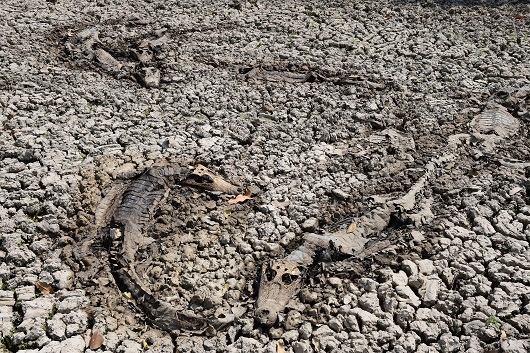
The months of unprecedented fires can lead several species to extinction, putting at risk the unique biodiversity of the largest wetland in the Americas (photo: Peter Ilicciev)
“One of our lines of action is to assess the impact on the health of firefighters, who are working directly with the fires. These people are exposed to risks that can be irreversible. Our proposal is begin with a pilot study, with a small sample, to verify the health conditions of the population, including the firefighters, more directly affected by the fire, the smoke and the heat”, explains Fiocruz researcher Sandra Hacon, responsible for the human health axis of the work. “In a second moment, we will also need to understand the medium- and long-term effects on local populations, in particular the more vulnerable ones, checking for markers of respiratory diseases and mother-child health indicators”, she adds.
The climate and the fires influence each other mutually. On the one hand, the lack of rain, the low relative humidity of the air, and the high temperatures increase the inflammability of the vegetation, favoring large fires. On the other hand, large burned areas degrade the soil and release toxic minerals and materials in the water and gases in the atmosphere, intensifying the drought and climate changes, resulting in temperature increase. This ensemble of factors increases the frequency and intensify of fires in the long run.
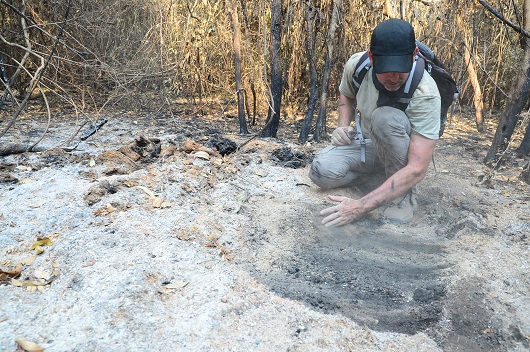
The field researchers recorded and documented the general situation for sharing with other research groups and analyzing the impacts of biodiversity loss in the region (photo: Peter Ilicciev)
The researchers in the field have recorded and documented the general situation to share with other research and analysis groups for the impact of the loss of biodiversity in the region. The group worked in the areas of Cuiabá, Cáceres, Poconé, and Barão de Melgaço. They visited local and riverside communities, as well as areas where the Firefighting Command of the State Secretary of the Environment in Mato Grosso (Sema/MT) is working, and the base of the Private Reserve of Natural Heritage (RPPN) of Sesc-Pantanal, where Fiocruz has already done a multidisciplinary project and where it maintains a study on Pantanal landscapes, with José Luiz Cordeiro, of Fiocruz Ceará, in a partnership with the National Museum of the Federal University of Rio de Janeiro (UFRJ). The group met with local partners, health secretaries, and the population directly impacted by the fires.
During the activities, the local population was introduced to and taught to use the Information System for Wild Health (SISS-Geo), which allows for the immediate and systematic registration of animal mortality in the areas already burned, and of living animals as well. The SISS-Geo platform uses geo-referenced records supplied with the collaboration of the society in order to create models of alert and prediction of zoonosis. The idea is to offer workshops to the population so that users are enabled to use the system in a continuous manner, integrating the participative surveillance in health.
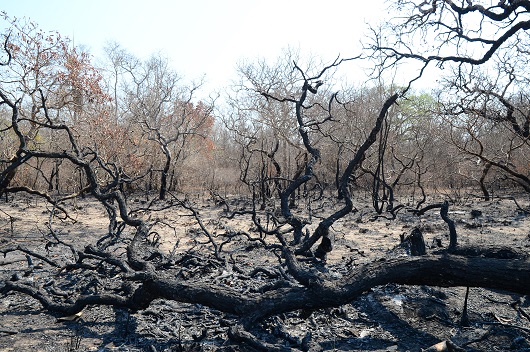
For the Fiocruz researcher who coordinated the fieldwork, Marcia Chame, “the scale of these fires really is huge, both because of the extent of the fire and because of its intensity and duration” (photo: Peter Ilicciev)
“Based on the data provided by the population by the app, we can generate early alerts of diseases in wild fauna, especially those that can potentially involve humans, and models of prediction of ecological opportunities for the emergence of diseases. The data are open and the results are made available to the society, making early surveillance possible for zoonosis”, explains Marcia Chame, who is also the coordinator of the Information Center for Wild Health (Ciss-Fiocruz).
The actions and studies of Fiocruz in the Pantanal area are being elaborated in a partnership with the post-grad course in Environmental Sciences of the State University of Mato Grosso (Unemat), the Federal University of Mato Grosso (UFMT), Sesc-Pantanal, the Chapada dos Guimarães National Park and the State Secretary for the Environment of Mato Grosso (Sema-MT).

